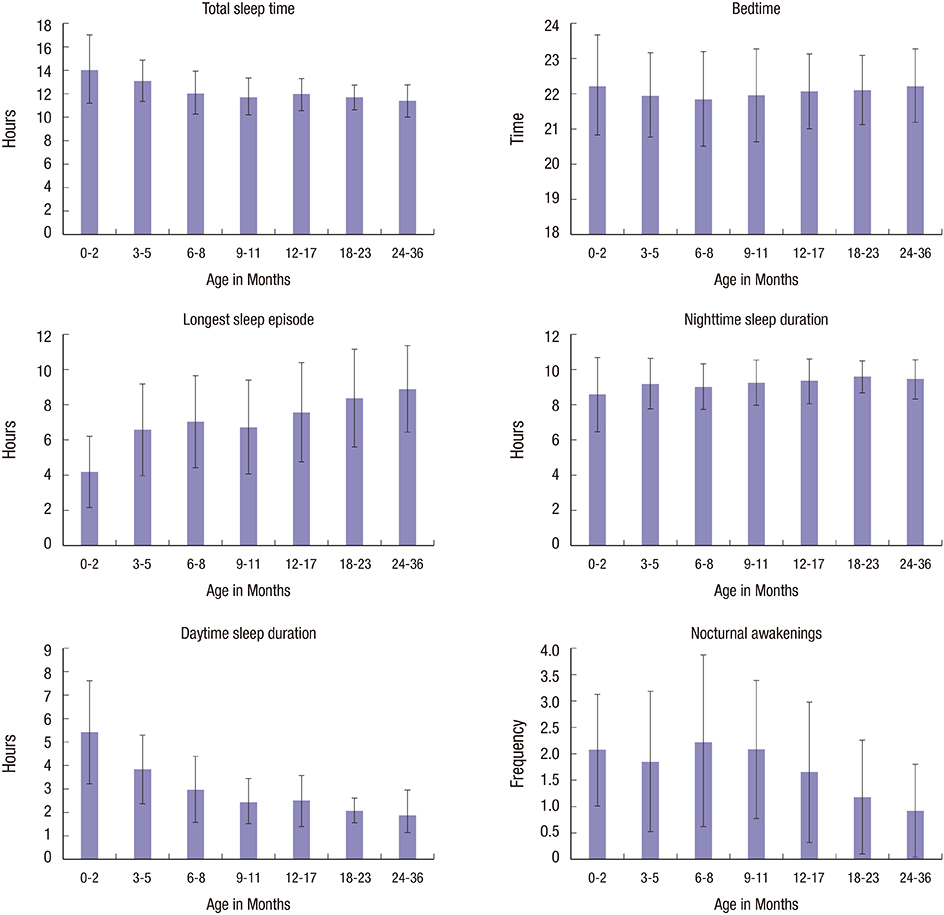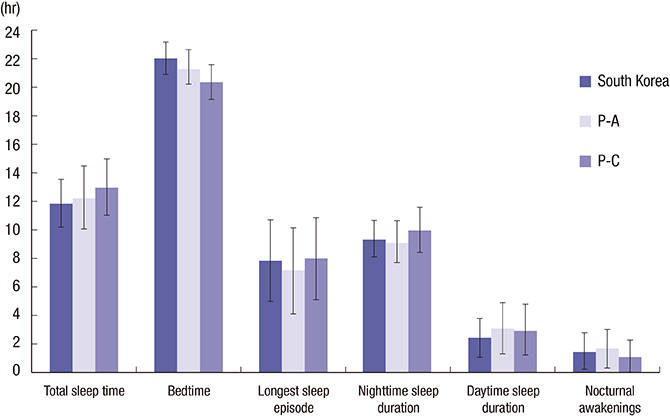J Korean Med Sci.
2016 Feb;31(2):261-269. 10.3346/jkms.2016.31.2.261.
Sleep Patterns among South Korean Infants and Toddlers: Global Comparison
- Affiliations
-
- 1Department of Pediatrics, Eulji General Hospital, Eulji University School of Medicine, Seoul, Korea. aym3216@eulji.ac.kr
- 2Department of Psychological and Brain Sciences, University of Delaware, Newark, DE, USA.
- 3The Children's Hospital of Philadelphia, Philadelphia, PA, USA.
- 4Department of Pediatrics, Seoul Medical Center, Seoul, Korea.
- 5School of Psychological Sciences, Tel Aviv University, Tel Aviv, Israel.
- 6Department of Psychology, Saint Joseph's University, Philadelphia, PA, USA.
- KMID: 2360051
- DOI: http://doi.org/10.3346/jkms.2016.31.2.261
Abstract
- The purpose of this study was to examine sleep patterns in a large sample of infants and toddlers (ages birth to 36 months) in Korea, and to compare sleep patterns, sleep problems, sleep ecology, and parental behaviors to global sleep data on young children in both predominately Asian (P-A) and predominately Caucasian (P-C) countries/regions. We additionally examined parent and child demographic information, parental behaviors, and aspects of the sleep ecology as predictors of sleep patterns among infants and toddlers in Korea. Parents/caregivers of 1,036 Korean infants and toddlers completed an expanded, internet-based version of the brief infant sleep questionnaire. Consistent with other studies of sleep in early childhood, sleep/wake patterns became increasingly consolidated with older child age for the Korea sample. Compared to both P-A and P-C infants and toddlers, children in Korea had the latest bedtimes, shortest total sleep and daytime sleep durations, and the least frequent rates of napping. Even though half of parents perceive their children's sleep problematic, parental perceptions of severe child sleep problems were the lowest. Within Korea, breastfeeding and bottle-feeding at sleep resumption were associated with increased nocturnal awakenings. Evening television viewing was associated with later bedtimes, which may have implications for sleep hygiene recommendations in clinical practice. The current study provides important information about sleep/wake patterns, parental behaviors, and aspects of the sleep ecology for infants and toddlers for physicians to support healthy sleep in Korea.
MeSH Terms
Figure
Reference
-
1. Mindell JA, Sadeh A, Kohyama J, How TH. Parental behaviors and sleep outcomes in infants and toddlers: a cross-cultural comparison. Sleep Med. 2010; 11:393–399.2. Mindell JA, Sadeh A, Wiegand B, How TH, Goh DY. Cross-cultural differences in infant and toddler sleep. Sleep Med. 2010; 11:274–280.3. Teng A, Bartle A, Sadeh A, Mindell J. Infant and toddler sleep in Australia and New Zealand. J Paediatr Child Health. 2012; 48:268–273.4. Jenni OG, O’Connor BB. Children’s sleep: an interplay between culture and biology. Pediatrics. 2005; 115:Suppl. 204–216.5. Sadeh A, Raviv A, Gruber R. Sleep patterns and sleep disruptions in school-age children. Dev Psychol. 2000; 36:291–301.6. Blampied NM, France KG. A behavioral model of infant sleep disturbance. J Appl Behav Anal. 1993; 26:477–492.7. Mindell JA, Kuhn B, Lewin DS, Meltzer LJ, Sadeh A; American Academy of Sleep Medicine. Behavioral treatment of bedtime problems and night wakings in infants and young children. Sleep. 2006; 29:1263–1276.8. Sadeh A, Tikotzky L, Scher A. Parenting and infant sleep. Sleep Med Rev. 2010; 14:89–96.9. Beebe DW. Cognitive, behavioral, and functional consequences of inadequate sleep in children and adolescents. Pediatr Clin North Am. 2011; 58:649–665.10. Chen X, Beydoun MA, Wang Y. Is sleep duration associated with childhood obesity? A systematic review and meta-analysis. Obesity (Silver Spring). 2008; 16:265–274.11. Gangwisch JE, Malaspina D, Babiss LA, Opler MG, Posner K, Shen S, Turner JB, Zammit GK, Ginsberg HN. Short sleep duration as a risk factor for hypercholesterolemia: analyses of the National Longitudinal Study of Adolescent Health. Sleep. 2010; 33:956–961.12. Gregory AM, Sadeh A. Sleep, emotional and behavioral difficulties in children and adolescents. Sleep Med Rev. 2012; 16:129–136.13. Lee K. The crying pattern of Korean infants and related factors. Dev Med Child Neurol. 1994; 36:601–607.14. Park HS, Lee YE. A study on the sleep/activity pattern in normal early infants using NCASA (Nursing Child Assessment Sleep/Activity Record). Korean Parent Child Health J. 2000; 3:46–59.15. Kim MY, Koh HJ, Shin YH, Kim YH, Oh JA, Kim HY, Kim EJ, Kim YS. A study on the sleep activity pattern of the infant. Korean Parent Child Health J. 2000; 3:1–17.16. Lee KS, Park MH, Park JA. A study on infant sleep behavior patterns and sex differences and its related variables. In : Proceedings of 2008 Annual Meeting of the Korean Psychological Association; 2008 Aug 21-22; Korea Military Academy, Seoul. Seoul: Korean Psychological Association;2008. p. 474–475.17. Sadeh A. A brief screening questionnaire for infant sleep problems: validation and findings for an Internet sample. Pediatrics. 2004; 113:e570–7.18. Blair PS, Humphreys JS, Gringras P, Taheri S, Scott N, Emond A, Henderson J, Fleming PJ. Childhood sleep duration and associated demographic characteristics in an english cohort. Sleep. 2012; 35:353–360.19. Iglowstein I, Jenni OG, Molinari L, Largo RH. Sleep duration from infancy to adolescence: reference values and generational trends. Pediatrics. 2003; 111:302–307.20. Jiang F, Shen X, Yan C, Wu S, Jin X, Dyken M, Lin-Dyken D. Epidemiological study of sleep characteristics in Chinese children 1-23 months of age. Pediatr Int. 2007; 49:811–816.21. Quach J, Hiscock H, Ukoumunne OC, Wake M. A brief sleep intervention improves outcomes in the school entry year: a randomized controlled trial. Pediatrics. 2011; 128:692–701.22. Meltzer LJ, Mindell JA. Sleep and sleep disorders in children and adolescents. Psychiatr Clin North Am. 2006; 29:1059–1076.23. Sadeh A, Mindell J, Rivera L. “My child has a sleep problem”: a cross-cultural comparison of parental definitions. Sleep Med. 2011; 12:478–482.24. Thoman EB. Co-sleeping, an ancient practice: issues of the past and present, and possibilities for the future. Sleep Med Rev. 2006; 10:407–417.
- Full Text Links
- Actions
-
Cited
- CITED
-
- Close
- Share
- Similar articles
-
- Model Structure for Mother-Child Relationship for Korean Infants and Toddlers and Their Mothers
- Effects of e-Health Literacy, Parenting Stress, and Maternal Role Confidence on Children’s Health-Promoting Behaviors in Mothers of Infants and Toddlers
- The New Rome IV Criteria for Functional Gastrointestinal Disorders in Infants and Toddlers
- Sleep and Anger
- Sleep Characteristics in Infants



